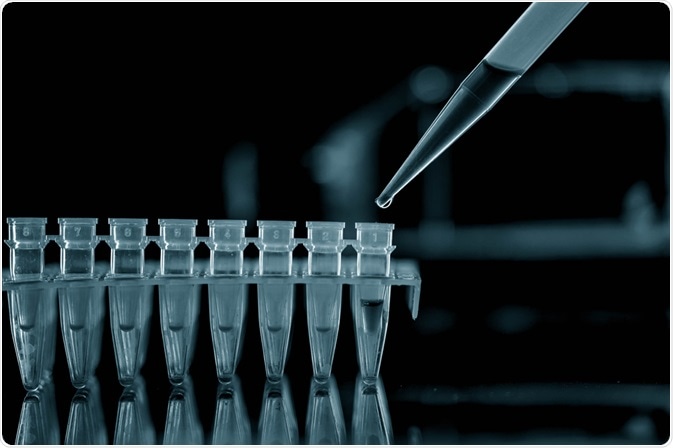The polymerase chain reaction (PCR) method has been around for almost 40 years and is integral to many areas of scientific laboratory work or research. Advancements in technology over the years have added to and refined the PCR technique, introducing quantitative PCR, which uses fluorescence to quantify the DNA, and reverse transcription PCR, which allows amplification of DNA from a strand of RNA. Recently, there has been a shift in focus to digital PCR, a technique that gives a direct absolute quantification of the amount of DNA.

PCR Test. Image Credit: luchschenF/Shutterstock.com
What is PCR?
PCR is a method used to amplify small DNA sequences and generate millions of copies. PCR requires a target DNA sequence to be amplified, forward and reverse primers complementary to the target sequence, a thermostable DNA polymerase (typically Taq Polymerase), dNTPs (deoxynucleoside triphosphates, used to synthesize the new DNA strands), divalent and monovalent cations, and a pH buffer.
Once all the components have been added, PCR relies on thermocycling, a process that can be categorized into three stages. The first stage is the denaturation of the template DNA. This takes place at high temperatures, typically over 90°C. The second stage is the annealing of the primers to the DNA templates.
The temperature required for annealing is dependent on the length and composition of the primers. The third and final stage is known as the extension or elongation phase. This typically takes place at 72°C and involves the synthesis of a new DNA strand. These three stages are repeated cyclically up to 35 times, amplifying the DNA at an exponential rate.
Whilst traditional PCR only amplifies the DNA, real-time or quantitative PCR (qPCR) measures the amount of DNA present, using fluorescence. qPCR offers both relative and absolute quantification. Relative quantification involves comparison to a reference sample, whereas absolute quantification requires the generation of a standard curve and is relative to a known amount, therefore is an indirect measurement.
What is digital PCR?
The primary difference between qPCR and digital PCR (dPCR) is that with dPCR, the sample is diluted into reaction chambers known as partitions, with most partitions containing only one, or no molecules of DNA. Each partition then undergoes the PCR reaction individually, without mixing with the other partitions.
If a PCR reaction takes place in a partition a positive answer is generated, whilst if a reaction does not take place a negative answer is generated. The initial amount of DNA is then calculated using a Poisson-distribution-based statistical analysis, using the fraction of negative reactions. This is therefore a direct method of absolute quantification, that does not require an endogenous control, reference sample, or generation of a standard curve.
dPCR was originally performed using standard plates containing either 96 or 384 wells, however, due to the fact that the number of partitions is one of the limiting factors in the sensitivity of dPCR, new technologies have been developed to utilize over 100,000 partitions through either chips or droplets. Chip methods rely on solid physical partitions, whilst droplet-based methods use emulsions of water in oil to form partitions out of individual droplets. This method allows many more partitions at a much lower cost, however is more technically complex.
Advantages of dPCR
For many experiments dPCR is not required as sufficient results can be generated from qPCR, however, dPCR does hold several advantages. One of the key advantages of dPCR is that it allows for direct measurement of copy numbers, without the need for a standard curve. This can greatly reduce the amount of time taken to carry out an experiment, as well as making the process theoretically more repeatable and reproducible.
dPCR can also provide increased precision and sensitivity over qPCR. This is particularly advantageous when trying to detect rare events, such as a rare allele in presence of many wild-type alleles. This may not generate a reading with qPCR, however, the limiting dilution carried out with dPCR means that if a rare variant is present in a particular partition, it is more likely to be detected. This is also an advantage when studying small differences and precise measurements, such as copy number variations.
Conclusions
dPCR does hold some disadvantages, such as only measuring partitions that successfully undergo amplification, and there is little information on the optimization of dPCR. As the cost of dPCR decreases and its use becomes more widespread, these issues will likely be considered and potentially rectified.
As with any technique, the value of a dPCR experiment is heavily reliant on a robust methodology, and the MIQUE guidelines (2013) give a strong recommendation for material to be included in any publication involving dPCR. Overall, though qPCR is still a useful technique for many experiments, dPCR is a powerful tool that can offer significant advantages over qPCR, and as such, the popularity of dPCR will likely continue to increase in the future.
Sources:
- Biocompare (2013). When to Go Digital — dPCR vs. qPCR. Available at: www.biocompare.com/Bench-Tips/130190-When-to-Go-Digital-qPCR-vs-dPCR/ [Accessed 25 May 2021]
- Green, MR., and Sambrook, J. (2019). Polymerase Chain Reaction. Cold Spring Harbour Protocols. 2019(6). DOI: 10.1101/pdb.top095109
- Hugger, JF., Foy, CA., Benes, V., Emslie, K., Garson, JA., Haynes, R., Hellemans, J., Kubista, M., Mueller, RD.,. Nolan, T., Pfaffl, MW., Shipley, GL., Vandesompele, J., Wittwer, CT., Bustin, SA. (2013). The Digital MIQE Guideines: Minimum Information for Publication of Quantitative Digital PCR Experiments. Clinical Chemistry. 59(6), 892-902. DOI: https://doi.org/10.1373/clinchem.2013.206375
- Vogelstein, B., and Kinzler, KW. (1999). Digital PCR. PNAS. 96(16), 9236-9241. DOI: https://dx.doi.org/10.1073%2Fpnas.96.16.9236
Further Reading